Bannerstones
October 2009
By Edward Chaney, MAC Lab Deputy Director
There is a famous story about an archaeologist who took an ancient and intact spear point, broke it in half, and handed it to a shocked
student, saying "same information." The point of the story is that archaeologists should value what artifacts tell us about the past,
but not the objects themselves. While this is true, we would be less than human if we didn't occasionally stop to admire the aesthetic
qualities of certain artifacts. And among the most artistic objects made in prehistoric Maryland was a type of stone tool called a "bannerstone."
 |
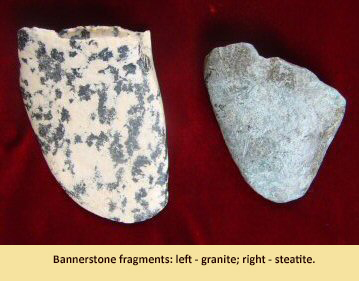 |
Completed bannerstones were carefully shaped and polished objects, generally symmetrical, with a perforation hole running longitudinally through
the midsection. They came in a wide range of sizes and shapes, and were made from a variety of hard and soft stones. They are found
throughout eastern North America, and first appeared in the archaeological record around 6000 B.C., disappearing sometime after 1000 B.C. Bannerstones
are fairly rare finds, which is not surprising given the hours of labor required to make one. The raw material had to be flaked and
pecked to create the basic shape, then laboriously polished smooth. A hole, sometimes several inches long, was drilled through the stone using nothing more than sand and a reed or stick.
 |
|
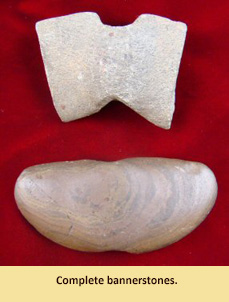 |
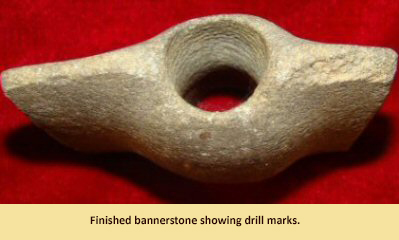 |
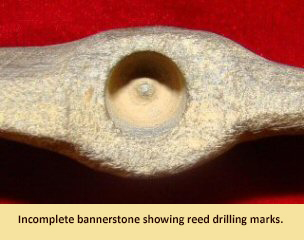
|

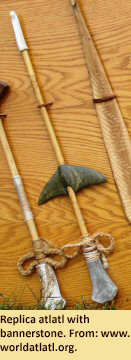 Early archaeologists thought that bannerstones were ceremonial objects carried on poles, like banners. This idea changed when bannerstones
and similar artifacts were discovered in association with atlatls, or spear throwers ("atlatl" is the Aztec word for the device). Atlatls
are typically hooked sticks used to improve the velocity and accuracy of a thrown spear or dart. When the end of the spear is placed into
the hook of a hand-held atlatl, the length of the thrower’s arm is, in essence, extended. This means that, when throwing, force
is applied to the spear for a longer period of time, thus increasing the spear's velocity. Skilled use of an atlatl can easily double the distance of a spear throw, while improving accuracy.
Early archaeologists thought that bannerstones were ceremonial objects carried on poles, like banners. This idea changed when bannerstones
and similar artifacts were discovered in association with atlatls, or spear throwers ("atlatl" is the Aztec word for the device). Atlatls
are typically hooked sticks used to improve the velocity and accuracy of a thrown spear or dart. When the end of the spear is placed into
the hook of a hand-held atlatl, the length of the thrower’s arm is, in essence, extended. This means that, when throwing, force
is applied to the spear for a longer period of time, thus increasing the spear's velocity. Skilled use of an atlatl can easily double the distance of a spear throw, while improving accuracy.
Atlatls were used throughout the world, but only in North America were weights often added to them. These weights came in a wide variety of shapes
and sizes, including the bannerstone style, which was only used east of the Mississippi. The added mass provided by the weight presumably
allowed a more forceful throw, but experiments have shown that only the smaller weights would work with all types of atlatls, and they improved
force by only a small amount. Larger weights, including most bannerstones, were only effective if the atlatl had a flexible, rather than rigid,
shaft. The fact that the average bannerstone hole, where it would slide onto the atlatl, was only about ½ inch in diameter,
indicates that they were indeed probably placed onto flexible shafts. 
Given the care with which they were made, bannerstones were probably more than merely functional. They may have reflected something about
the person who made and used them: social status, family or clan relationships, personal hunting charm, etc. Whatever their meaning,
whatever they can teach us about past behavior, today we can, at the very least, stand back and admire the artistry and skill of their creators.
| References |
|
| Baer, John Leonard |
| 1921 |
A Preliminary Report on the So-Called Bannerstones. American Anthropologist 23 (4):445-459. |
|
| Howard, Calvin D. |
| 1974 |
The Atlatl: Function and Performance. American Antiquity 39(1):102-104. |
|
| H |
| ranicky, Wm. Jack |
| 1995 |
Prehistoric Axes, Celts, Bannerstones, and Other Large Tools in Virginia and Various States. Archeological Society of Virginia Special Publication 34, Courtland, VA. |
|
| Kwas, Mary L. |
| 1981 |
Bann | erstones as Chronological Markers in the Southeastern United States. Tennessee Anthropologist 6(2):144-171. |
|
| Palter, John L. |
| 1976 |
A New Approach to the Significance of the "Weighted" Spear Thrower. American Antiquity 41(4):500-509. |
|